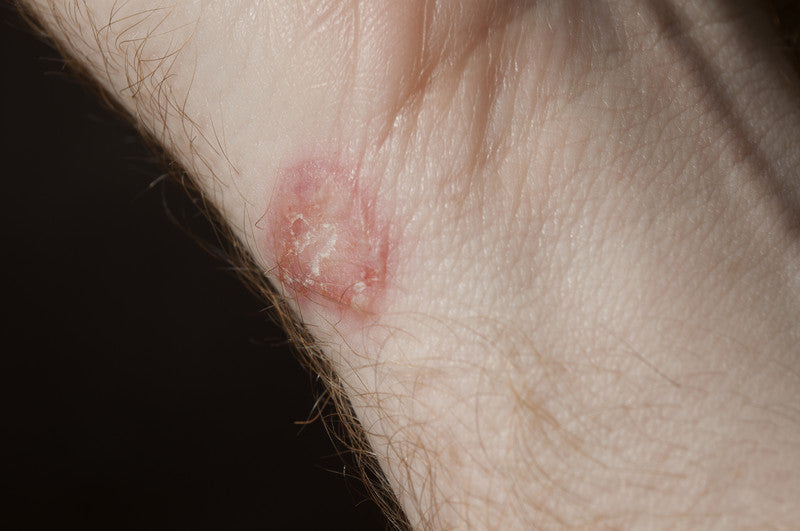By Dr Peter Klapper Ph.D
What is ringworm? Ringworm is a common fungal infection of the skin. Fungi are tiny plants that survive by eating plant or animal material. The ringworm fungi feed on keratin found in the outer layer of skin, hair, and nails. These fungi thrive best on skin that is moist, hot, and lacks exposure to light. When this fungal infection is found on the feet, it is called athlete's foot; when it is found in the groin, it is called jock itch; and when it is found on the body, it is called ringworm.
Up to 20% of the population has one of these infections at any given time. To become infected with ringworm, you must be exposed to it and susceptible. Some people are more resistant than others.
Those with eczema or various other skin conditions tend to get ringworm more easily because the protective barrier of the skin's outer layer is weakened by the existing condition. Children are more susceptible before puberty. Boys tend to get it more easily than girls. It is believed that some people are genetically predisposed and can get it easily throughout life. Children primarily get it on the scalp (this is uncommon for adults); adults experience it on the trunk, neck, extremities and skin folds.
The incubation period is unknown for most of these agents, however ringworm of the scalp is usually seen 10 to 14 days after contact, and ringworm of the body is seen four to 10 days after initial contact.
How do you prevent ringworm?
Ringworm prevention is not easy, and it cannot be completely avoided. Though it is also not extremely common. Fungus is present in almost all areas of our environment. Soil, animals, carpeting, shoes, people, and a whole host of fungal sources are present in our everyday lives.
Avoiding exposure is certainly the best measure to ringworm prevention. Because these fungi thrive best on skin that is moist, hot, and hidden from the light, dressing to keep the skin cool, dry, and light can also help prevent this infection.
Additional measures and practices can be adopted to enhance ringworm prevention:
- Stay clear of contact with individuals known to be infected. If contact is unavoidable, meticulously wash hands with soap and water.
- Refrain from sharing brushes and combs with anyone afflicted by ringworm.
- Be cautious about wearing hats or using headrests in areas where fungus may be present.
- Avoid walking barefoot on moist locker room floors.
- Exercise caution around infected animals, noting that dogs are believed to carry ringworm less frequently than cats.
The classic ringworm rash begins as a dry, raised, round patch, which may be slightly red. The patch may also be somewhat itchy. As it grows, the center of the patch clears, leaving a ring-like appearance. Not all children display this central clearing. In fact, there is wide variability in the way ringworm can appear from person to person.
Ringworm can be very contagious making prevention more difficult. Ringworm can be caught from other humans, both by direct contact and by prolonged contact with flakes of shed skin (from sharing clothes or from house dust, for instance). Wrestlers commonly spread it back and forth with their sweaty contact (tinea gladiatorum!).
Without treatment, most cases of ringworm would disappear spontaneously within several months, but they can become chronic. Infection of the skin surface frequently responds well to topical over-the-counter remedies like Forces of Natures Ringworm Remedy or other antifungal medications.
Usually these are applied several times a day after washing and drying the area. Read the label for the correct frequency recommended. And do NOT think that the infection is gone the instant the lesions start to fade (often after 7 days)! Treatment must be continued for another two to three weeks for complete cure. As soon as treatment has begun it's fine for your child to play with others, but it's best not to share clothing or to let other children rub the infected area.
Ringworm is often diagnosed by the history and physical examination and rapid response to treatment. The diagnosis can be confirmed by looking at skin scrapings under the microscope, where the fungus is visible. Also, ringworm lesions do not glow under ultraviolet light.
When fungus is found in the nails or on the scalp, the infection is much more difficult to eliminate and makes ringworm prevention more difficult as well. Prolonged treatment with a prescription oral antifungal medicine, as well as other topical treatments, is usually necessary. Scalp ringworm is a major cause of hair loss and should be treated aggressively.
If you think your pet may be involved, contact your veterinarian to get up-to-date information on the best treatment for animals.


